First Impressions - Fuji Velvia 100
Text and photography Copyright Guy Tal. All rights reserved.
Most film photographers will tell you there are ups and downs to every emulsion on the market. With so many uses and characteristics, there is almost an art to matching the right film to the right situation. Most of us narrow our selection to one or two that, once we are familiar with, provide consistent and predictable results within their limitations. My own two films of choice these past years have been FujiFilm's Velvia 50, and Provia 100F. I will use one or the other depending on the contrast range of a given scene, whether or not long exposure is needed, the quality of light, and other considerations. Yet, in some situations, I struggle with tough choices Velvia's palette vs. Provia's latitude, Velvia's exaggerated contrast vs. Provia's tendency to produce color casts, etc. The recent introduction of FujiFilm's Velvia 100F was preceded by a lot of exciting rumors fine grain, rich palette, and extra color correction layers. Once I was able to get a hold of Fuji's technical data sheet for the new film things got even more exciting claims of improved reciprocity characteristics allowing for exposure times up to a full minute with no need for either color correction or exposure compensation, extremely fine grain to match Provia 100F and excellent resolving power to match the older Velvia.
Issues of color, contrast, grain, speed, color casts, reciprocity, and resolving power are just a few of the things a film photographer may consider when deciding on the "right" emulsion for a given scene. With such a diversity of issues, field conditions, and individual preferences, I offer this as my personal first impression of Velvia 100F.
Being a landscape photographer, I was not too interested in things like push processing, rendition of skin tones, or indeed any other characteristics that might interest some of my colleagues who specialize in wildlife or people photography. I will leave these issues for someone more qualified in those areas.
This evaluation is a subjective assessment of things I find most pertinent to my own work:
- Color palette
- Sharpness
- Contrast and exposure latitude
- Reciprocity characteristics
- Ease of scanning
These were evaluated side-by-side with my two "standard" films mentioned above the original Velvia 50 and Provia 100F.
Equipment Used
All images were made with a Wista VX 4x5 camera and Nikkor lenses. A hand-held Pentax spot meter and grey card were used to accurately determine exposure within a 1/3 of a stop.
Scans were created using a Canon D2400UF desktop flatbed scanner at a resolution of 1200dpi, and color-matched to the chrome using a Levels adjustment layer in Photoshop.
The computer system was color-calibrated using a Pantone ColorVision Spyder device and OptiCal software before working on the scans.
Images appearing in this article were converted to sRGB, resized, and sharpened (with identical settings for all scans) with no other adjustments, unless otherwise specified.
Scene 1: Mountain Meadow
I chose this scene for its high contrast and rich color. Capturing contrasty scenes is a common challenge with slide film due to its inherently narrow latitude. Past experience taught me to be careful not to blow out highlights or lose shadow detail. Neither Provia nor the original Velvia offered a perfect solution, with the former more prone to lose highlights and the latter to block up shadows. This scene offered a great test case due to:
- Large pure-white areas and neutral grey rocks useful in evaluating color casts
- Many shades of green a strong point of the original Velvia and somewhat weak for Provia 100F (which seems to shift them towards blue in shadows)
- Brightly lit foreground and somewhat shaded background a good test for the limits of each film's exposure latitude
The scene was composed using a Nikkor W 150/5.6 with the addition of a warming polarizer filter to compensate for haze and reduce specular highlights on the vegetation. Exposure was calculated for the highlights as a matter of practice with slide film.
Exposure was as follows:
- Provia 100F, Velvia 100F: 1/8 sec. @ f/25 (minus 1/3-stop from f/22)
- Velvia 50: 1/4 sec. @ f/25
On the Light Table
A first look placed Velvia 100F closer to the original Velvia in terms of color saturation, although not quite as extreme, which is more to my liking. The Provia chrome was noticeably more muted.
Greens are much more vivid and warm in both Velvia chromes than Provia.
The Velvia 50 chrome appears darker than the other two, verifying many photographers' opinion that it is in reality a slower film than its designated rating (closer to ISO 32 or 40).
Under an 8x loupe all chromes show fantastic sharpness and grain and retain detail well in the highlights (remember the exposure was calculated to preserve highlight detail). Shadow detail is similar in the 100-speed films, both noticeably better than the original Velvia in that sense (some of this can likely be attributed to the slight underexposure in the latter).
The thing I was most excited about here was the way the new film renders whites they were cleaner and brighter than the older Velvia which produced a slight green/yellow cast in the white flowers.
Scan Results
One peculiar observation is a distinct red cast in the Velvia 100F scan. My guess is that its caused by the new film's extra color correction layers but I don't know enough to tell for sure. I wouldn't be surprised if special scanner profiles are produced for this film that will correct this phenomenon. The following scans are color-matched to their original chromes (you will need a color-calibrated monitor to best assess the differences). Other than color matching, resizing, and sharpening, no further adjustments were performed.
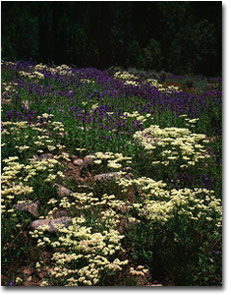
Fuji Velvia 50 |
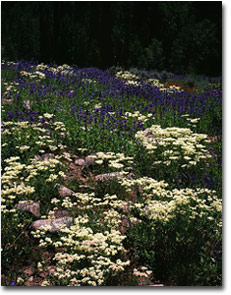
Fuji Velvia 100 |
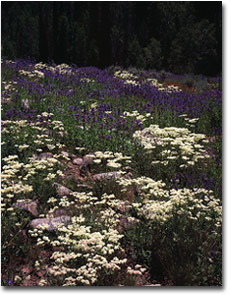
Fuji Provia 100F |
Shadow detail:
In order to judge shadow detail, I used the raw scans, without the color-matching layer. All images were converted to grayscale using Photoshop's Channel Mixer, and overall brightness was increased by 40%. At full magnification scanner artifacts are very obvious, but differences in detail are easy to spot.
Provia F has noticeably better shadow detail in this scene. Both Velvia emulsions captured slightly less detail and are fairly similar.
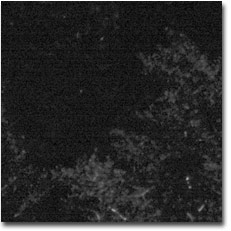
Fuji Velvia 50 |
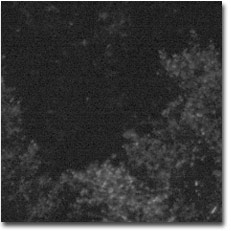
Fuji Velvia 100 |
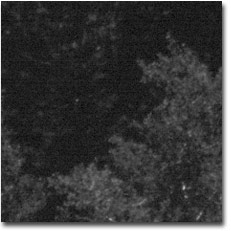
Fuji Provia 100F |
Some loss of detail in the scan is undoubtedly due to this particular scanner's limited dynamic range. Still as claimed above this is a subjective test and for many Large Format photographers a flatbed scanner goes with the territory.
Scene 2: Alpine Lake Detail
I chose this as a complimentary scene to the previous one a thin cloud layer obscured the sun for a few seconds, allowing me to capture this scene in even light (the Velvia 100F image was made last as the cloud began to move, resulting in slight flare). This is my preferred light to work with as I can fit more detail within the latitude afforded by the film. Other characteristics that made this scene a good candidate:
- Pure white elements (snow drifts) to evaluate and correct color by
- The ability to capture very fine detail in vegetation (the air was still) to evaluate sharpness and resolving power
The scene was composed using a Nikkor SW 90/8 wide angle lens with the addition of a Tiffen 812 filter to eliminate haze and punch up the foliage.
Exposure was as follows:
- Provia 100F, Velvia 100F: 1 sec. @ f/45
- Velvia 50: 1 sec. @ f/32
On the Light Table
Velvia 100F once again came in between the original Velvia and Provia brighter than the former and more vibrant than the latter.
All 3 films captured wonderful detail in all areas of the image from the foreground water and vegetation to the crags and waterfalls (hard to see at this size, but believe me - they are there) in the cliffs.
Provia actually retained some pink cast as a result of using the filter. This cast is not evident in either Velvias.
To my personal taste, Velvia 100F is the color winner in this round as well colors are more realistic than Velvia 50 and much livelier than the pale Provia palette.
Scan Results
This low-key scene was much easier to scan and even the lowly flatbed extracted an impressive amount of detail from all 3 chromes. The red cast was once again present in the Velvia 100F scan and required some correction.
The following scans are color-matched to their original chromes:
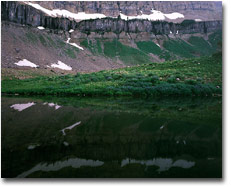
Fuji Velvia 50 |
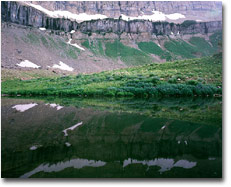
Fuji Velvia 100 |
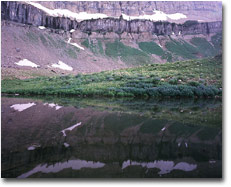
Fuji Provia 100F |
Shadow detail was similar on all three, which is to be expected (the scene is well within the scanner's dynamic range and the film's latitude).
Scene 3: Waterfall After Dark
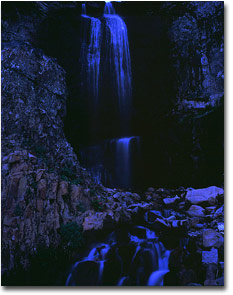 My sole purpose for this image was to do a preliminary evaluation of the new film's reciprocity. I hiked to this waterfall under a full moon and exposed for 8 minutes at f/22. This is about as much as my scanner is willing to extract, but the chrome actually maintains a good amount of detail in the shadows. It is, however, very grainy and will likely not print well, especially if smaller formats are used. This obviously went a bit too far for this emulsion. I will continue to test it within a more reasonable range (30 seconds 1 minute) so keep watching NPN for a followup!
My sole purpose for this image was to do a preliminary evaluation of the new film's reciprocity. I hiked to this waterfall under a full moon and exposed for 8 minutes at f/22. This is about as much as my scanner is willing to extract, but the chrome actually maintains a good amount of detail in the shadows. It is, however, very grainy and will likely not print well, especially if smaller formats are used. This obviously went a bit too far for this emulsion. I will continue to test it within a more reasonable range (30 seconds 1 minute) so keep watching NPN for a followup!
Conclusions
While working on this article, I read a number of other photographers' evaluation of this film most of them expressed disappointment at the fact that it was not as saturated as the original Velvia. I strongly disagree with their opinion (which goes to show you how subjective film choice is).
Velvia 100F's palette is far more pleasing to me than either the original Velvia 50 or Provia 100F it is just saturated enough to bring an image to life and still be believable (something Velvia 50 achieves only some of the time). I also found its rendition of primary colors (red, green, blue) more even, whereas the original Velvia tends to favor greens while over-saturating reds and blues.
While Provia 100F achieves better shadow detail and possesses slightly wider exposure latitude for low-key scenes its muted palette and tendency to produce a blue cast makes it less attractive. I will likely continue to use it but limit its use to high-contrast scenes.
I am reluctant to make hard and fast decisions based on this preliminary evaluation, but so far it seems more than likely that Velvia 100F will replace Velvia 50 in my photo pack. It is a true ISO-100 film, with a pleasing and saturated palette. It seems to saturate all colors evenly which to me translates into more predictable results.
To some the less saturated palette was a disappointment. To me it's the film's greatest strength and what will likely win it the distinction of becoming my new "standard" color film.
Editor's Note - Guy Tal is a fine art landscape photographer based in Salt Lake City, Utah. You can view some of his work on the web at http://scenicwild.com. Guy and fellow NPN member Michael Gordon offer exclusive landscape photography workshops in some of the West's most scenic areas. More information available at the web site.
Guy Tal - NPN 440
Comments on NPN nature photography articles? Send them to the editor.


| 


